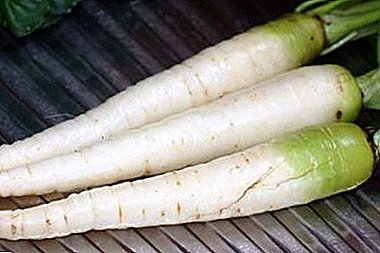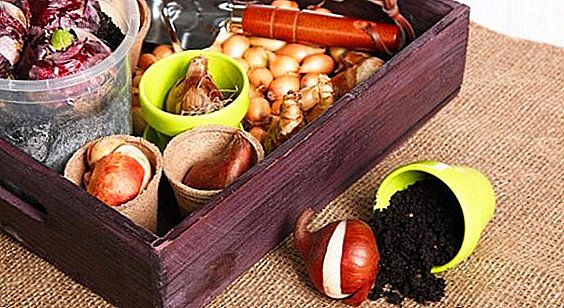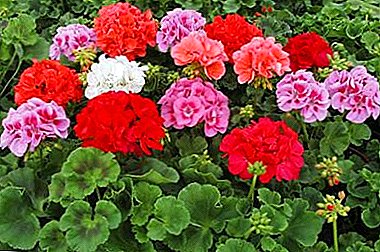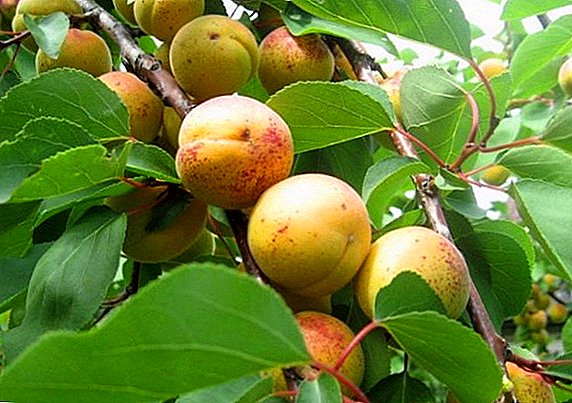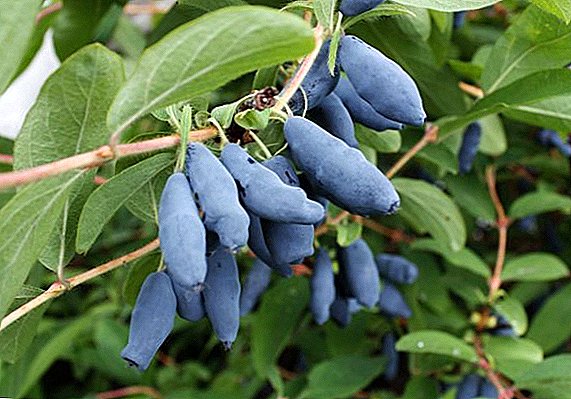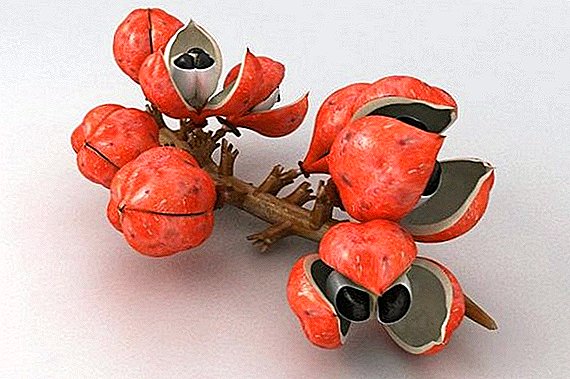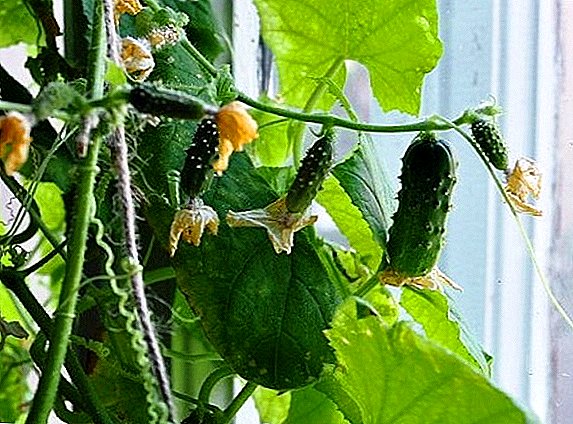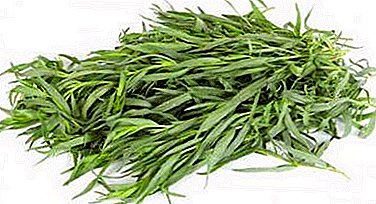
Fragrant tarragon, otherwise called tarragon, and in Latin "dracunculus", which means "dragon", is known to many as the main component of lemonade. Did you know that this plant can be easily grown at home? In the article we have collected all the necessary information.
Next, tell about the most suitable varieties of plants for growing at home, show their photos. You can get acquainted with the methods of breeding tarragon and tips on caring for him.
The best varieties for growing at home
Goodwin
It is one of the most famous and fragrant varieties. A small plant in height, up to a meter will be pleasantly pleased with abundant and dense green part. This variety is good for use as a seasoning, as it has a piquant taste with a slight bitterness.

A detailed description of tarragon varieties Goodwin can be viewed on this video:
Emerald
Also applies to undersized varieties of tarragon. Its height rarely exceeds 80 centimeters, so it can also be grown at home. It has a refreshing and invigorating aroma of foliage..

Gribovsky-31
This variety has long established itself as one of the most successful for growing. Height up to one meter, besides the variety is resistant to diseases and frost.

Zhulebinsky Semko
Individual plants may not exceed a height of 60 centimeters. The maximum height is 150 centimeters. The hostess really likes this variety, since the spicy-spicy flavor of the leaves of this tarragon is used for many dishes in the kitchen.
From the experience of those who like to grow tarkhun at home: pot plant height rarely exceeds 0.5 meter. At the same time, the choice of a variety does not play a special role, unless one chooses a deliberate variety - “giants”.

Where and how to plant?
For tarragon lighting is extremely important. If the light is missed, the greens will lose both the color and the taste characteristics.
An ideal place for growing tarhuna will be the eastern sill. The plant needs sunlight, but direct rays are detrimental to foliage.
Important! In winter, all plants lack light, including homemade tarragon. For additional illumination use fluorescent lamps.
Land composition is suitable as a universal seedling, it can be purchased at a specialty store. You can also prepare a mixture of turf + coarse river sand + peat crumb in a ratio of 1: 1: 1.
Growing tank
The material for the pot is not basic, any one will do.. The size of the pots can be chosen small, since the root system of the tarragon is quite compact. The shape of the pot is also not strictly fixed, here you can choose according to your preferences. Someone wants to have a small compact bush on the window, and someone will like the whole balcony container.
A prerequisite for growing is the presence of drainage at the bottom of the selected pot. Suitable claydite, ceramic chips.
Breeding methods
Seeds
In order not to “buy a cat in a bag” and not to find wormwood instead of tarragon in a pot, you should buy seed only in specialized stores, and when choosing seeds, you should give preference to proven companies, “AU-selection”, “Aelita”, “Our garden” and so on.
 Before planting, it is necessary to arrange a seed test: check for buoyancy.
Before planting, it is necessary to arrange a seed test: check for buoyancy.
- You must take a glass of water and fill half of it with warm water.
- Throw the seeds and wait about four hours.
- Quality seeds should drown. They need to be selected for further work.
Before direct planting, the seeds must undergo pretreatment: you can soak in any disinfecting agent for 8 hours, for example, in a weak solution of potassium permanganate, then put it in the "bath" with a means to accelerate growth for 3 to 4 hours. Next, you can follow this algorithm:
- Prepare a medium-sized pot if you want to plant immediately to a permanent place or a container of the size you need if you want to prepare seedlings. Ensure that there are tapped holes at the bottom of the tank.
- Put on the bottom of the selected tank for planting drainage layer of 2-2.5 centimeters.
- Pour the soil. The soil composition is described above.
- Mix seeds with a little sand. This will give a better grip to the ground.
- Spread the seeds over the surface zamyl, slightly deepening them. Nebole than 1 to 2 cm.
- Cover the planted seeds with cling film, making small holes for air penetration.
- After the appearance of the first shoots (about 7-14 days), remove the film. Maintain a temperature of 15-18 degrees.
Immediately in a separate and permanent pot
This algorithm is suitable for growing both in a permanent pot and in seedlings. Only capacities will differ.
Further, the algorithm described above is carried out and when the sprouts throw out the first two leaves, it is possible to leave some of the strongest shoots.
To seedlings
In order to grow the tarragon for seedlings, you can use peat pots or a large seedling box. Sowing is done in the first half of March.. When the seeds according to the described algorithm come up and separate two leaves, you need to make a dive. That is, leave only the strongest shoots at a distance of 5-6 centimeters from each other.
In the open ground, the permanent seedlings are planted in June. Allowed to plant 2 to 3 pieces per well. As a rule, seedlings are transferred to a moist and fertilized soil in a wide row pattern of 30x60-70 centimeters.
Cuttings
 Cuttings are taken from a healthy plant.:
Cuttings are taken from a healthy plant.:
- In the third decade of May, a 15 centimeters long stalk is cut.
- The cut-off side is lowered into the root and every other day they are planted in a medium-sized container of any material, with suitable soil. Deep about 4-5 centimeters.
- The cuttings are covered with a film or an empty plastic can, thus simulating greenhouse conditions. The film must be regularly raised to the cutting "breathing". Moisturize the soil.
- Planted to a permanent place in a month. By this time, new leaflets appear on the handle.
Dividing bush
- In order to carry out reproduction by division, you need a healthy plant older than three years.
- After the soil warms up, you need to dig a bush out of the ground and divide it to form several pieces with 2-3 growth buds.
- In this case, the root system must be separated manually, the knife or pruner can not be used.
- New parts are immediately planted in the ground and watered, but moderately.
- The first time, about 3 weeks protect from direct active sunlight.
Layering
For this method, you need a healthy plant older than 1.5 years:
- The stem of the plant is “pinned” in a previously dug groove or groove with a v-shaped wooden stud.
- Sprinkle the pinned part with soil.
- At the bottom of the stem, the one facing the ground, make several notches.
- The soil is constantly kept hydrated.
- Next spring, the rooted stem is cut from the mother plant and transferred to a new location.
How to care for tarragon?
- Temperature. The best temperature will be 18-25 degrees.
- Watering should be moderate. It is necessary to spray every two days, but water it once or twice a month.
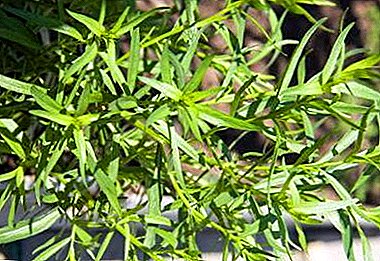 Shine. Necessary, but without direct sunlight. Best of all the lighting from the east window.
Shine. Necessary, but without direct sunlight. Best of all the lighting from the east window.- Loosening. Constant, so as not to form a "crust" on the surface of the earth.
- Weeding. Weeds, of course, do not often disturb owners of potted plants, but if they detect "foreign elements" in a pot, they should be removed.
- Top dressing. Begin to enter from the second year of life of the plant. Use mineral fertilizers purchased in specialized stores.
When and how to harvest?
It is possible to collect fragrant greens after the appearance of the first buds in the first year of planting and up to August. Typically, the interval between sections of the harvest from one bush is 30 days. Secateurs or large scissors carefully cut off the entire ground part, leaving 7-8 centimeters.
Briefly about diseases and pests
Of the insects, tarragon is best suited to aphids, bedbugs and wireworms. The fight against them is made with the help of specialized insecticides.
Of the diseases most prone to rust. It appears due to too close planting or an excess of nitrogen in the soil. It is treated by thinning and changing the soil, respectively.
Summing up, I would like to say that such a beautiful plant as tarragon can really be easily grown even on a windowsill. We hope that the reader has found answers to many questions and filled in the gaps of his knowledge of tarragon.


 Shine. Necessary, but without direct sunlight. Best of all the lighting from the east window.
Shine. Necessary, but without direct sunlight. Best of all the lighting from the east window.